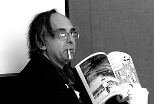Cartoonist Art Spiegelman, renowned for dark irony and demanding text, amiably discussed his own work, the history of comics and the possibility that MAD magazine was the "hidden cause" of anti-Vietnam War protests in two days of talks at MIT on Sunday and Monday, March 16 and 17.
"Comics have the power to fly under the critical radar and dive right into the brain. They get to the heart of what happens. They turn time into space. They're the power of still images in a world where everything is moving," said Spiegelman, dressed in black and wearing an upside-down peace symbol pin.
The Sunday talk, titled "Comix 101," attracted an overflow crowd to Wong Auditorium. It was the 41st William L. Abramowitz Lecture at MIT.
Spiegelman, 55, is best known for "Maus," his unique graphic cat-and-mouse tale of the Holocaust, which won the Pulitzer Prize in 1992. Until recently a designer for The New Yorker, Spiegelman created the cover of the magazine immediately following Sept. 11, 2001. Its mournful twin black rectangles on a black background became an icon for the destroyed and unforgettable World Trade Center towers.
The twin towers still cast their shadow on Spiegelman, whose home and studio are walking distance from ground zero.
Recalling the hours after the towers burst and fell, Spiegelman said, "I wasn't going to be any good at pulling people out of the rubble, so I worked on that cover instead."
For solace and inspiration after Sept. 11, Spiegelman, father of two, turned to comics such as "Hogan's Alley," a turn-of-the-20th-century slum scene. He showed one, "The Birth of Cruelty," to the MIT audience, noting, "You can see the moral outcome. The boy who was cruel to dogs gets hanged and dogs eat his intestines."
His current work is a glossy, densely drawn comic titled "In the Shadow of No Towers," published by the London Review of Books.
"It's my reporting on the war inside my own head. It's also my way of trying to assimilate what happened on September 11 and what's happening with this miserable adventure we're about to embark on," he said, referring to a looming U.S. attack on Iraq.
"September 11 taught me some lessons. One, cigarettes may not be what kills me. Two, I understood why the Jews didn't leave Germany after Kristalnacht: I loved New York. I wasn't leaving. And three, I was wasting my time doing anything besides comics," he said.
Spiegelman discusses "Maus" with a chef's delight in a good recipe: it came out well; it keeps working; it always brings pleasure.
"Comics are an architectural structuring; the stories are 'built' on the page like buildings. What I had to do in 'Maus' was find ways not to interfere with my father's storytelling and also to make the action clear.
"Using small frames bracketed inside larger frames allowed me to freeze time while my father was speaking and to compare times within his story. 'Maus' could be in both Poland and Queens," Spiegelman said.
"Maus," Spiegelman noted, was a product of its technological time; it was painstakingly hand drawn. Spiegelman uses computer software to produce "No Towers."
A fan, a historian and a collector of comics, Spiegelman offered a lineup of the cartoonists whose work had economy of text and images. Mainstream strips he liked included "Nancy," "Donald Duck," "Calvin and Hobbes" and even "Peanuts," for its "metronomic rhythm."
Spiegelman singled out MAD magazine for its artistic and political impact.
"MAD inspired me; it was a big influence on 'Maus.' MAD brought us 'Mickey Rodent' to show how to question the authority of Mickey Mouse. MAD figured out how to balance satire and reporting, how to question all authority," he said.
A version of this article appeared in MIT Tech Talk on March 19, 2003.






